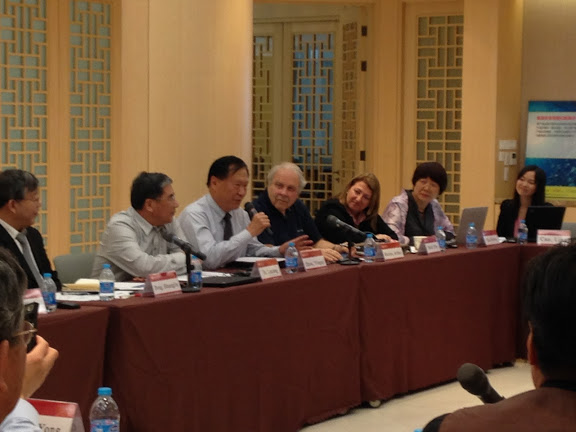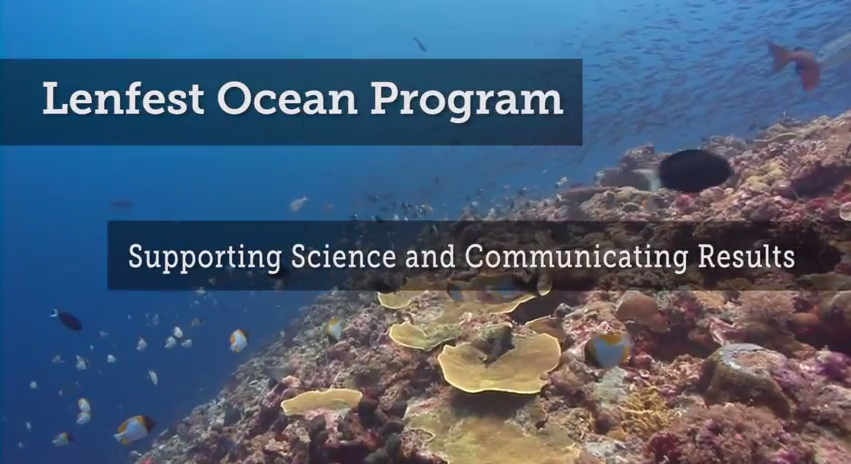Can China Couple Continued Growth with Fisheries Sustainability?

Art Hanson (Center) at the first China food security symposium in Beijing last year, will attend the second symposium this March in Shanghai.
This month 30 scientists will convene at a symposium to discuss how our oceans will meet rising demands for seafood. It’s fitting that they are gathering in Shanghai. It’s one of 160 Chinese cities with more than a million people. To put that in perspective, the United States has just nine. Chinese incomes are climbing, and so is pressure on oceans as a source of protein. Whether fishing and aquaculture can meet China’s growing concerns about food security is a hot topic.
Last year, the group met in Beijing for the first time, convened by Stanford University’s Center on Food Security and the Environment and the Lenfest Ocean Program. Several researchers from the group had already worked together on a paper, published in January in Science, on how China’s aquaculture industry relies on fishmeal from wild-caught fish, placing huge pressure on fish stocks and ocean ecosystems. This year, the broader group hopes to discuss some of the challenges around management of China’s domestic fisheries.
China, of course, is only one player in a large global fishing fleet: In the past 40 years, the worldwide seafood catch has doubled to around 80 million metric tons. China – along with the U.S. and European Union – is in a position of great responsibility to lead the world in establishing sustainable fishing practices, said Art Hanson, international chief advisor and member of the China Council for International Cooperation on Environment and Development.
Hanson is one of the 30 experts meeting in Shanghai to discuss food security and he’s one of the foremost experts on linking science to public policy, and works closely with government bodies in Canada, the United States and throughout Asia on specific problems related to natural resources and environmental management. In recent years much of his professional time has been spent working with China, which is at a critical point in balancing its environment and development priorities.
“In China, the biggest concerns for the environment are happening right now,” said Hanson. “They have grown so much, so quickly with economic concerns routinely trumping environmental considerations.”
At the same time, he emphasized the potential for China to contribute giant leaps forward in sustainability, noting that “major advancements to science and technologies” are emerging from the country. Yet the government has identified the “Blue Economy” as a new source of continued economic growth, according to Hanson, who indicates that sustainable ocean use is far from certain in China’s ocean space, or in its fisheries and aquaculture activities elsewhere.
If the scene feels eerily familiar, it is because it is not unlike the United States’ path to tighter fisheries management in the 20th century, during which fishing fleets decimated numerous fish populations before lawmakers recognized the need for catch limits and other measures that allow species to recover from heavy fishing pressure. Populations of Atlantic cod and herring, as well as Pacific sardines, had collapsed during that period.
Today, more than 60 percent of the world’s aquaculture-generated seafood is produced in China, and the country imports forage fish catch from around the world for use in aquaculture feeds. China’s growth is also coming at a time of much greater concern over the state of the world’s fisheries: many major marine fisheries around the world are already in decline and may not be able to withstand increased fishing pressure, according to the world’s leading marine scientists.
Shifting toward more sustainable fisheries for China, as with any large country, is complex, said Hanson, as it requires seeing the oceans’ fisheries as an interconnected system. Indeed a substantial portion of the world’s wild-capture fish now pass through China for processing, consumption by Chinese consumers or as food for fish farms.
“There’s great interest in China among scientists in becoming more sustainable and eco-friendly because there is such an opportunity to collaborate on many environmental issues,” said Hanson. “We have a lot to learn from each other.”
After the meeting in Shanghai this month, symposium participants will begin on research proposals to address the scientific needs identified at the symposium and start drafting a series of peer-reviewed publications addressing fisheries and food security in China.


This video is hosted by YouTube. In order to view it, you must consent to the use of “Marketing Cookies” by updating your preferences in the Cookie Settings link below.
This video is hosted by YouTube. In order to view it, you must consent to the use of “Marketing Cookies” by updating your preferences in the Cookie Settings link below.

